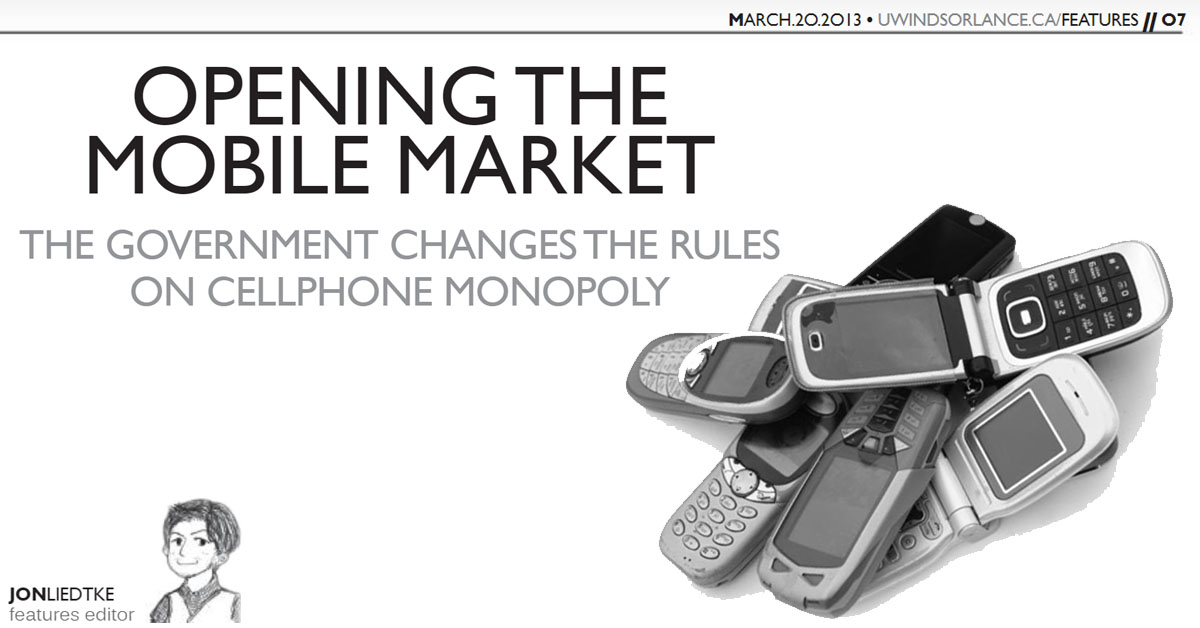UWindsor Lance
Issue 35, Volume 85
March 20, 2013
Jon Liedtke
The Government Changes the Rules on Cellphone Monopoly
Industry Canada recently announced changes towards increasing competition with
mobile phone providers to give Canadians more choices, newer technology and better prices.
“Our government’s priority is to provide greater wireless coverage at lower rates for
consumers. Wireless services are changing our families, our work and our economy,” said federal industry minister Christian Paradis. “The importance of these technologies is undeniable. They increase productivity, spur economic growth, create jobs and enhance the quality of life of Canadian families.”
On March 7, Minister Paradis said the government would be reviewing the policy on spectrum licence transfer requests with the objective of promoting a competitive environment, expanding and extending the requirement for companies to provide roaming to competitors, strengthening cell tower sharing rules to reduce proliferation and increase services and ensuring at least four providers in every region of the country have the opportunity to acquire spectrum in the upcoming 700 MHz spectrum auction.
“These changes build on previous measures such as the set-aside of AWS spectrum
in 2008 for new entrants, and those announced in March 2012 to encourage competition and investment in the sector, including the introduction of spectrum caps to support a fourth player in every region and relaxing foreign investment
restrictions for carriers with less than 10 per cent market share,” said Michel Cimpaye, communications advisor for Industry Canada.
Extending the requirement for wireless companies to provide roaming on their networks to competitors ensures that cell users will be able to access a network regardless of where they are as “no Canadian should be left stranded simply because he or she is outside the range of the chosen service provider,” said Paradis.
By tightening the rules to increase cellphone tower sharing, the government is seeking to cut down on the proliferation of cell towers which is, according to the minister, a “major concern across the country while ensuring national wireless coverage for consumers.”
The upcoming November wireless spectrum auction is also aimed towards ensuring there are four competitors in each region of the country.
“This can only be good for consumers and will lead to better choices and lower prices,” said Cimpaye, who added that the independent Canadian Radio-Television and Telecommunications Commission is “examining the issue of cell phone contract terms, among other issues, as part of its wireless code of conduct hearings.”
With regulatory changes that prompted the emergence of Wind Mobile in Canada, cell consumers have a new option, rather than the traditional Big 3 (Bell, Rogers and Telus).
Algis Akstinas, senior marketing manager for Wind, said the benefits of belonging to Wind mobile over one of the other telecoms are quite apparent.
“We bring obviously some key differentiators into the market,including the value, simplicity [of] no contract and unlimited features … That was a key differentiator we entered the market with and we keep on focusing on needs,” said Akstinas.
“When we started … these were the things that the Canadian market lacked, they had a lot of hidden fees, so we brought in transparency, [there] were limited plans, so we obviously wanted to differentiate with unlimited things. Almost zero options [were] available for prepaid subscribers, so subscribers who don’t have good credit, we brought them equality between prepaid and post-paid plan and no need for credit checks,” Akstinas said, adding that Wind wanted to focus on simplicity because they “wanted to save our own resources and we didn’t want to confuse [the] Canadian market with too many options.”
Akstinas believes that the reason the bigger telecoms didn’t offer those services in the past was because the Canadian market lacked competition. “…that’s when things like hidden fees, complicated plan options thrived … if you have more competition, these things would for sure go away.”
Today, one of the biggest obstacles Canadian cellphone consumers face is that it’s difficult and penalizing to go from one carrier to another.
“Our position was always [that] increased competition in the market allows consumers to move around the companies easier and that’s I think one of the biggest issues in the market,” explained Akstinas. “When you’re locked into a
contract, when you cannot leave without a big penalty, that makes the market less
competitive and it’s one of the biggest problems for consumers because they don’t have good options.”
Many claim large telecoms are a regulated cartel in Canada and point to their pricing structures, similar services and identical launch dates of new cellphones as evidence.
When asked what he thought about such a claim, Akstinas laughed and responded,
“Maybe it’s a very harsh assessment, but I think it’s a fair assessment.”
“Competition wasn’t functioning and it’s still not functioning [as best as it can] … we see it every day in the market. We see the same plans, we see the same launch dates, we see the same moves … there is no differentiation,” said Akstinas.
Opening the mobile market
Issue 35, Volume 85
March 20, 2013
Jon Liedtke
Page 7
Jon Liedtke was the Features and Opinions Editor, Associate News Editor, Advertising Manager and Deficit Consultant at the UWindsor Lance.




Leave a Reply